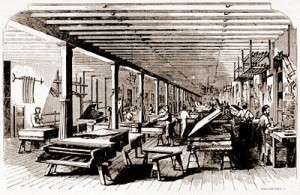 Most of the day Walter libero crouches down and peers into darkness. in his left hand he holds a mirror aimed into a piano’s dimly lit underside. His right hand splays over the keys, plunking one in a questioning way. The sound is honeyed and round. “that could use some juicing,” he says after a pause. Deftly he extracts the hammershank from the piano’s guts and dabs the felt end—the surface that hits the strings directly—with a few drops of clear lacquer. The hammer is replaced, and he plunks again. Now the sound is fuller, sharper, and more brilliant. “If you want a brighter, louder sound, we use the lacquer,” libero explains. “If you want a softer, mellower sound, we prick the felt with needles.” Every Steinway is “voiced” like this several times before leaving the factory and often doctored again by tuners for individual taste at home or the concert hall.
Most of the day Walter libero crouches down and peers into darkness. in his left hand he holds a mirror aimed into a piano’s dimly lit underside. His right hand splays over the keys, plunking one in a questioning way. The sound is honeyed and round. “that could use some juicing,” he says after a pause. Deftly he extracts the hammershank from the piano’s guts and dabs the felt end—the surface that hits the strings directly—with a few drops of clear lacquer. The hammer is replaced, and he plunks again. Now the sound is fuller, sharper, and more brilliant. “If you want a brighter, louder sound, we use the lacquer,” libero explains. “If you want a softer, mellower sound, we prick the felt with needles.” Every Steinway is “voiced” like this several times before leaving the factory and often doctored again by tuners for individual taste at home or the concert hall.
One hundred and fifty years old this year, Steinway & Sons wrestles with the problem of answered prayers: bluntly put, their piano design trounces all others. more than 90 percent of concert grand pianos worldwide are Steinways. The only reason most holdouts don’t use Steinways is simply because they can’t afford to. Revered for handcrafting pianos using many centuryold techniques and holder of 126 piano design patents, Steinway’s pianos are nearly universally regarded as perfect. But to the creative engineer and marketer, perfect can get boring. how does Steinway keep its design and production processes fresh—not to mention its brand? What design innovations streamline the process and reinvigorate a nearly perfect design, and which steps shouldn’t be tinkered with? And what’s the magic under the hood anyway? Step toured the Steinway factory in Astoria, Queens, to get to the bottom of it.
Bending the rim
“We’re dealing with wood, leather, and felt—things with a lot of variability,” says Gregory Sims, engineering manager and a Steinway employee for 14 years. It’s the variability of natural materials that gives each Steinway its personality, but also demands a production and design process that is shockingly manual to get everything right.
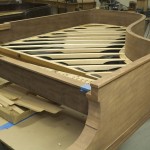 Bending the rim is the first step in the 8-month-long process of creating a Steinway Model D concert grand. This is classic man vs. nature stuff: You take 18 slender layers of maple wood, finger-groove, and then glue them together in a single piece more than 20 feet long. Then get six burly guys from Queens to wrestle the thing into a steel vise shaped like a grand piano, silently puffing and grunting while salsa tinkles from the radio into the empty factory air. And give them only 20 minutes to do it, before the glue dries.
Bending the rim is the first step in the 8-month-long process of creating a Steinway Model D concert grand. This is classic man vs. nature stuff: You take 18 slender layers of maple wood, finger-groove, and then glue them together in a single piece more than 20 feet long. Then get six burly guys from Queens to wrestle the thing into a steel vise shaped like a grand piano, silently puffing and grunting while salsa tinkles from the radio into the empty factory air. And give them only 20 minutes to do it, before the glue dries.
Past engineers may have toyed with new ideas for the rim design, but you wouldn’t know it from this He-Man contest. The vise, or “rim press,” these guys are using was invented by C.F. Theodore Steinway in 1880 and hasn’t been touched since. It makes a perfectly tight, single-sheet rim, one that’s beautifully veneered and strong enough to take up to 400 ppi of pressure from the strings. One recent tweak involves a rim-dryer with an FM transmitter that speeds the glue drying once the rim is bent into shape. The ideal rim grasps every piece of the piano and silences all of them from thrumming—all but the vibrating strings and soundboard.
Soundboard is the motherboard
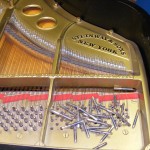 The strings vibrate, but they need muscle to be heard. The soundboard, a curved piece of Sitka spruce that fits under the strings and amplifies the sound, can rightly be called the soul of a Steinway. Soundboard design is ticklish. On one hand, it’s the most evolved of all of Steinway’s engineering processes and must be protected by rigorous ongoing inspection. On the other hand, Steinway engineers can’t stop tinkering with it, hoping to beat nature somehow. Ironically, most of their efforts go toward improving the look of the soundboard as much as the sound. “This instrument is made of wood [and] needs to expand and contract with the seasons, from the dry winter to the humid summer,” says Sims. “What happens over time is that the soundboard expands and contracts and develops ridges so that it looks rough, but functionally it doesn’t do anything to the instrument—it actually starts sounding better.” A customer’s best bet is to control humidity around the piano to an ideal 40 percent, which also maintains accurate tuning on the strings.
The strings vibrate, but they need muscle to be heard. The soundboard, a curved piece of Sitka spruce that fits under the strings and amplifies the sound, can rightly be called the soul of a Steinway. Soundboard design is ticklish. On one hand, it’s the most evolved of all of Steinway’s engineering processes and must be protected by rigorous ongoing inspection. On the other hand, Steinway engineers can’t stop tinkering with it, hoping to beat nature somehow. Ironically, most of their efforts go toward improving the look of the soundboard as much as the sound. “This instrument is made of wood [and] needs to expand and contract with the seasons, from the dry winter to the humid summer,” says Sims. “What happens over time is that the soundboard expands and contracts and develops ridges so that it looks rough, but functionally it doesn’t do anything to the instrument—it actually starts sounding better.” A customer’s best bet is to control humidity around the piano to an ideal 40 percent, which also maintains accurate tuning on the strings.
The changing supply of wood over the years has also required design to evolve. “The wood keeps getting scarcer and scarcer,” Sims says. “We want this slow-growth, old Sitka spruce, with growth rings at a certain count. The newer trees that are growing
faster just don’t have that.” Sitka spruce comes from Alaska, Canada, and other parts of the Pacific Northwest—areas that have recently been invaded by mass-market Japanese pianomakers like Yamaha and Kawai. Yamaha’s hunger for piano-grade wood feeds a production capacity of 200,000 pianos per year. Steinway’s production of 3,000 pianos per year—560,000 over the lifetime of the firm—means they’re much more finicky with their wood. Knots, branches, and wormholes disqualify up to three-quarters
of the wood brought into the factory as soundboard-grade material. With the growing Asian market and its new factory in China, Steinway woods have also been subtly adjusted to perform better in the jungle-like humidity of the Pacific Rim.
One more item for the environmentalists: elephant poaching for piano keys is definitely over. You can add real ivory keys to your piano for an extra $50,000—on top of the more than $90,000 you’re already paying for a Model D. “You have to have good traceability,” Sims notes as we climb some gritty stairs. “It’s OK [to use ivory] if the elephant died naturally.”
Action and bellies
The rim’s tight, the soundboard loose and flexible. Now you need keys—more accurately called the action. A piano’s action includes an intricate arrangement of felt-covered hammers, joints, and dampers linked to the foot pedals that move together to hit a string and then dampen the sound if the player wants.
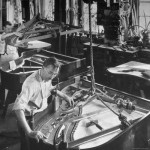 Action-making at the Steinway factory involves a dizzying number of people. We pass rows of ladies who smile shyly as they spool red felt into a wooden joint from the action. Someone hops out of line to hand me a half-made hammershank to keep; it’s pear-shaped, with a thin purple heart of felt hidden under wool-white. I can see, as Sims points out, how the red felt minimizes friction when a metal screw is eventually inserted in the hole. Even the tiniest friction of wood against metal might produce an ugly vibration. In the past 10 years, Steinway has streamlined action-building by upgrading nearly half of the old cam-driven machines to PLC (programmer logistic controller) models, standardizing the cut for the action’s many teeny parts.
Action-making at the Steinway factory involves a dizzying number of people. We pass rows of ladies who smile shyly as they spool red felt into a wooden joint from the action. Someone hops out of line to hand me a half-made hammershank to keep; it’s pear-shaped, with a thin purple heart of felt hidden under wool-white. I can see, as Sims points out, how the red felt minimizes friction when a metal screw is eventually inserted in the hole. Even the tiniest friction of wood against metal might produce an ugly vibration. In the past 10 years, Steinway has streamlined action-building by upgrading nearly half of the old cam-driven machines to PLC (programmer logistic controller) models, standardizing the cut for the action’s many teeny parts.
Meanwhile, the bellymen are gearing up for a tense step in the process. At least I’m tense: These guys root around the hollow wood rim all day with a couple hundred pounds of cast iron dangling loosely over their heads. We watch as one guy drops the iron plate into the piano’s belly. Graphite edging the plate makes marks on the rim and braces, places where the wood must be shaved off for a more exact fit. The iron plate anchors the high-tension strings; as the biggest piece with the most jangle-potential, its fit must be exact against the rim. A new generation of iron engineering might make for a lighter cast iron, reducing the Model D’s considerable weight. “In the ’70s and ’80s, there was some experimenting with a graphite-carbon composite [in the industry], but it just didn’t fly,” says Sims. “Cast iron’s dampening capacity is ideal because it doesn’t create any overtones.” A steel plate would stand up to the string tension and reduce the piano’s weight but also produce a nasty treble ringing sound when struck.
Bellymen train for six to nine months to do their work and swagger a little as a result: On the wall in their section, I see a ragged poster of Superman, relabeled “Steinway Man.”
Marketing great-grandpa
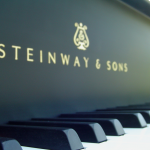 If everything is humming at the factory in Astoria, these Steinways are definitely just like your great-grandpa’s piano. Still, with a new generation of piano consumers, marketing has to finesse the message for relevance today. Steinway’s newest targets include more institutions, especially in China—churches, smaller concert halls, and aspiring music programs at universities. “Other pianomakers rotate their pianos [into university concert halls] for free, but we sell them outright,” says Leo Spellman, director of advertising and public relations for Steinway. The University of Oklahoma just purchased 105 pianos last spring and graduated to become one of 30 “All-Steinway schools” worldwide.
If everything is humming at the factory in Astoria, these Steinways are definitely just like your great-grandpa’s piano. Still, with a new generation of piano consumers, marketing has to finesse the message for relevance today. Steinway’s newest targets include more institutions, especially in China—churches, smaller concert halls, and aspiring music programs at universities. “Other pianomakers rotate their pianos [into university concert halls] for free, but we sell them outright,” says Leo Spellman, director of advertising and public relations for Steinway. The University of Oklahoma just purchased 105 pianos last spring and graduated to become one of 30 “All-Steinway schools” worldwide.
For many customers, a Steinway is, bluntly speaking, a piece of furniture as much as a musical instrument, so company designers focus on the piano’s look as well as the sound. Karl Lagerfeld designed a limited-edition Model A for the firm’s 150th anniversary, and countless designers have collaborated with special piano designs in the past. The “Crown Jewel” series offers handcrafted pianos in 12 exotic veneers like East Indian Rosewood, Macassar Ebony, and Kewazinga Bubinga (a West African timber similar to rosewood).
Looming in a storage shed near the end of my tour is an electric-green grand piano with brilliant tangerine and yellow keys, created by glassblower and designer Dale Chihuly for the opening ceremony of the 2002 Winter Olympics. Dale was “part pirate, part Picasso,” Spellman remarks, smiling. “We really liked him—and his piano.”
Source: http://www.judestewart.com
